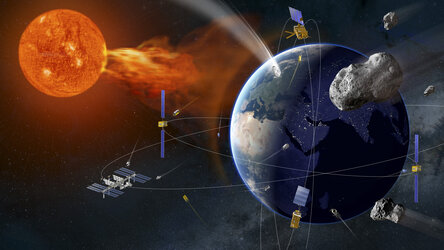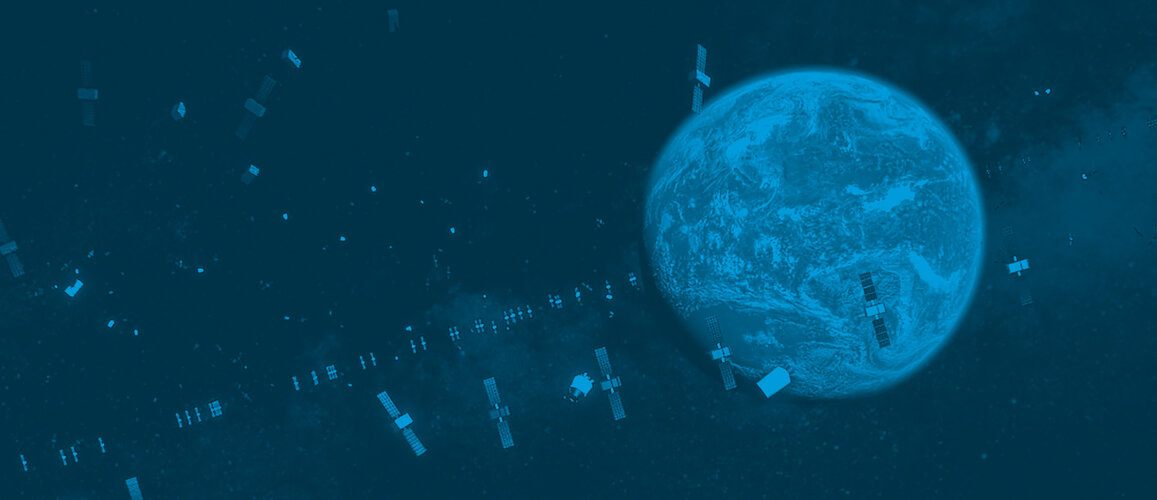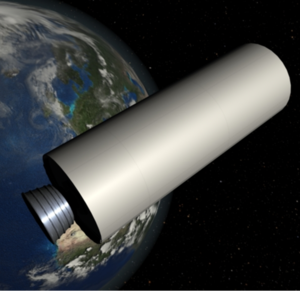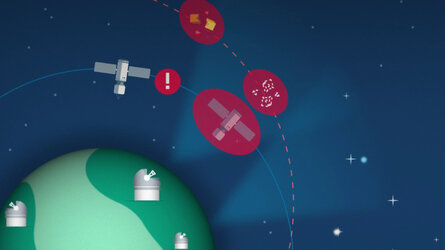Hubble's impactful life alongside space debris
During its 30 years in orbit around Earth, the NASA/ESA Hubble Space Telescope has witnessed the changing nature of spaceflight as the skies have filled with greater numbers of satellites, the International Space Station was born and in-space crashes and explosions have created clouds of fast-moving space debris.
Hubble itself has felt the impact of this debris, accumulating tiny impact craters across its solar panels that evidence a long and eventful life in space. So what can we learn from these impacts, and what does the future hold for Hubble?

In 1993, the first Shuttle mission to ‘spruce up’ Hubble was conducted. By providing the space observatory with corrective optics, it was suddenly able to take the incredibly sharp images of the Universe loved by the world over.
While the astronauts were there, they replaced the observatory’s solar arrays which had been ‘jittering’ due to temperature fluctuations. One of the panels was disposed of in orbit, later burning up in Earth’s atmosphere, but the other was brought back down to Earth.
Part of ESA’s contribution to Hubble was to design, manufacture and provide its solar arrays in exchange for observation time, meaning the returned array was available for the Agency to inspect.
This was one of the earliest opportunities in the history of space exploration to see the impact of more than two years in space on an orbiting satellite. The team discovered hundreds of impact craters pocketing the surface of just a small section of the solar array, ranging from microns to millimetres in diameter.

Nine years later, the solar panels were again replaced and returned to Earth this time having accumulated almost a decade of impact craters.
This array is now on display at ESA’s Technology Centre (ESTEC) in The Netherlands, but a tiny piece came to the ESOC mission control in Germany, home to the Space Debris Office.
Array of evidence of Hubble’s early bombardment
Although we don't know exactly when each impact crater was formed, they must have occurred during the solar array’s period in orbit. As such, imprinted on them, is unique evidence of spaceflight activity during their time in space.
The impact craters were studied to determine their size and depth, but also to seek out potential new residues. Given that the chemical composition of the solar cell was known, ‘alien’ materials or elements could have been brought into the crater by the impactor.

Metals like iron and nickel would suggest an impact from a natural source – fragments of asteroids and comets known as micrometeoroids. The craters found in Hubble’s solar arrays however contained small amounts of aluminium and oxygen, a strong indication of human activity in the form of ‘solid rocket motor’ firing residues.
The space debris team, as part of a larger effort with partners in industry and academia, were able to match the shape and size of these craters to models of rocket firings that were known to have happened at the time, finding a match between craters observed and craters expected.
Was Hubble hurt?

These tiny particles, ranging from micrometres up to a millimetre in size, would have struck Hubble at huge relative speeds of 10 km/s, however they didn't have a major impact on the craft which continues to take incredible images of our Universe.
Such impacts occur quite frequently for all satellites, the main effect being a continuous but gradual degradation in the amount of power the solar arrays can produce.
New missions make use of a model created by the space debris team, based on early Hubble impact data, to predict how many impacts can be expected for each mission and what effect this will have on solar power.
Hubble still lives with the threat of collision

Imagine the Hubble spacecraft in orbit, residing inside a 1 km x 1 km x 1km cube. On average, at any moment, a single piece of micron-sized debris shares that cube with Hubble, because for every cubic kilometre of space around Earth, there is about one tiny debris object.
This doesn't sound like a lot, but Hubble itself is travelling at 7.6 km/s relative to Earth and so are these tiny fragments of debris. A large fraction of collisions between the two don't happen head on, but at an angle, leading to relative impact speeds of about 10 km/s.
For simplicity, imagine these particles are travelling at 10 km/s relative to a still Hubble. This is the same as ten of these fast-moving objects crossing in and out of Hubble’s cubic space every second. Because Hubble’s solar panels take up a large surface area, measuring approximately 7x2 m, they are more likely to come face-to-face with large numbers of these projectiles.


Access the video
Hubble today faces a similar threat from small debris fragments as it did soon after it was launched. While micron-sized particles are still being created today, the atmosphere at this low altitude, 547 km above Earth’s surface, also sweeps a number of them away.
However, the risk from larger objects is unfortunately also increasing. Debris fragments ranging from about 1-10 cm in size are too small to be catalogued and tracked from ground, but have enough energy to destroy an entire satellite. At Hubble's altitude, the probability of a collision with one of these objects has doubled since the early 2000s, from a 0.15% chance per year to a 0.3% today.
Hubble lives where mega-constellations plan to reside

Some satellites are launched today without the capability to change their orbit. Instead of manoeuvring at the end of their life, they can be inserted into relatively low altitudes so that over time Earth’s atmosphere pulls them down to burn up, including the region that Hubble calls home.
In addition, the total number of operational satellites being put into this region looks set to soon rapidly increase. Some broadband internet constellations, the largest of which are planned to contain thousands of satellites, have their sights set on these heights.
Space Safety at ESA

To help prevent the build-up of new debris through collisions, ESA's Space Safety programme is developing ‘automated collision avoidance’ technologies that will make the process of avoiding collisions more efficient, by automating the decision processes on the ground.
But what about the debris that’s already out there? In a world first, ESA has commissioned an active debris removal mission that will safely dispose of an item of debris currently in orbit. The ClearSpace-1 mission will target a 100 kg Vespa rocket part, left in orbit after the second flight of ESA’s Vega launcher back in 2013.
With a mass of 100 kg, the Vespa is close in size to a small satellite. Its relatively simple shape and sturdy construction make it a suitable first goal, before progressing to larger, more challenging captures by follow-up missions – eventually including multi-object capture.




















